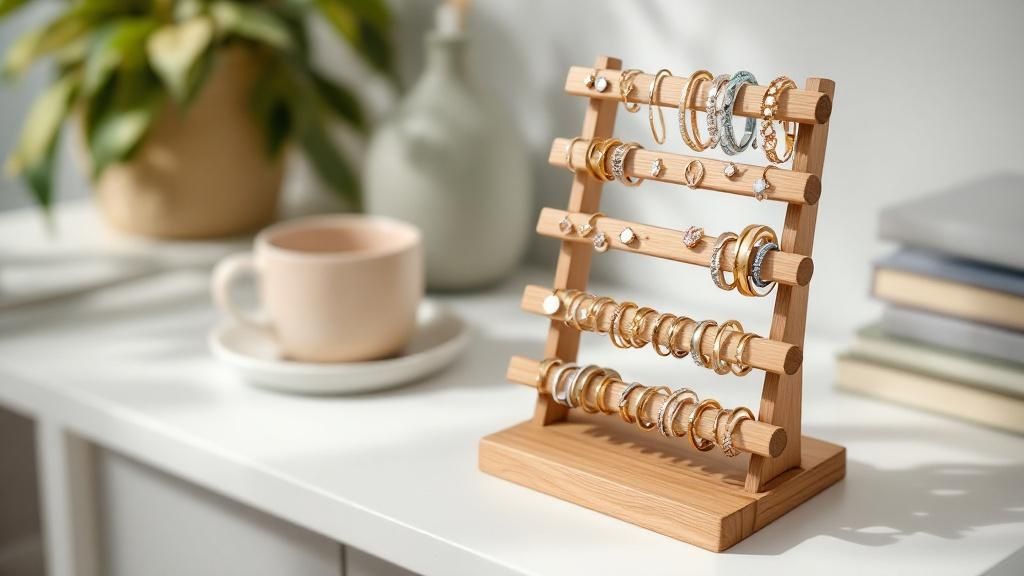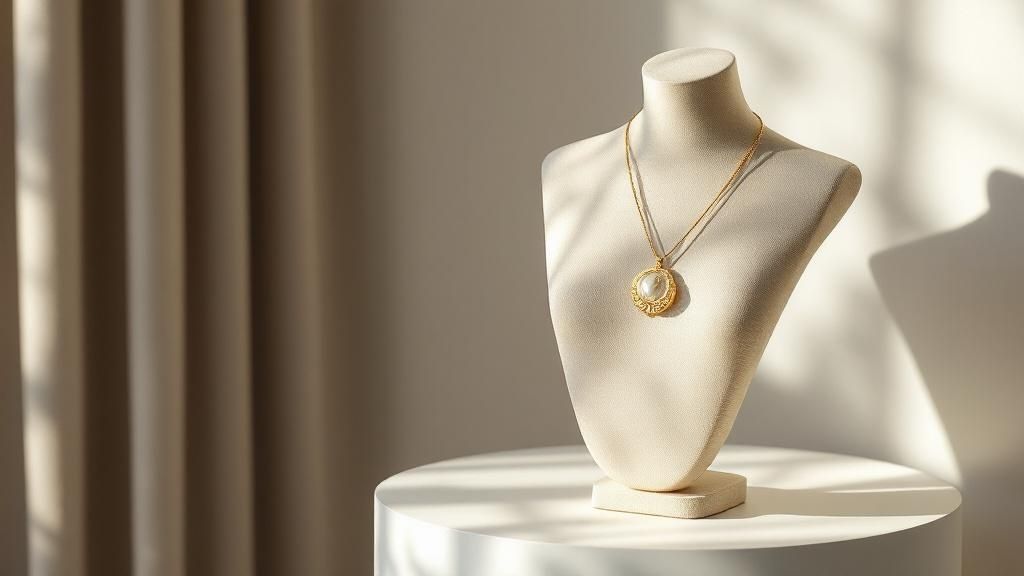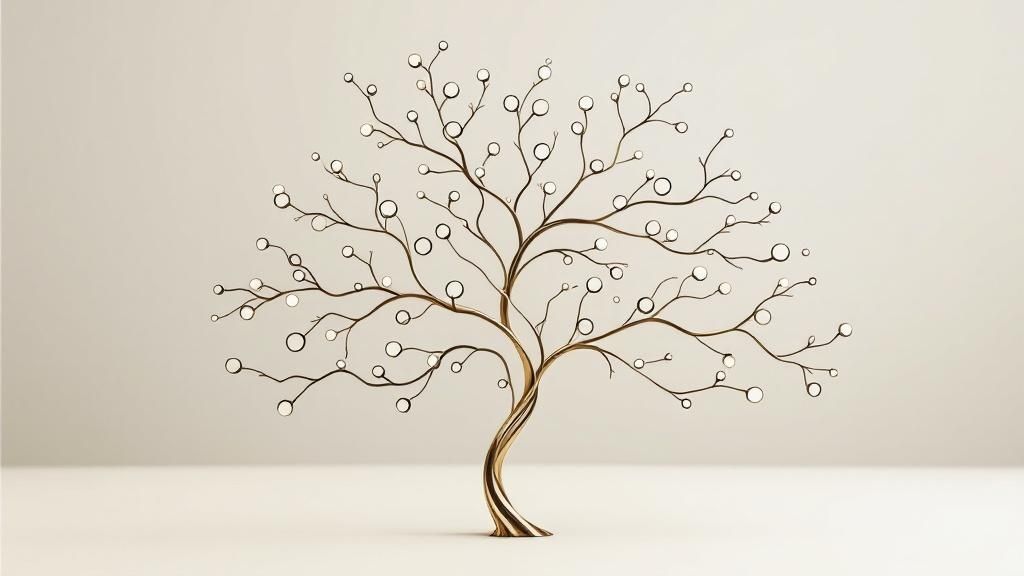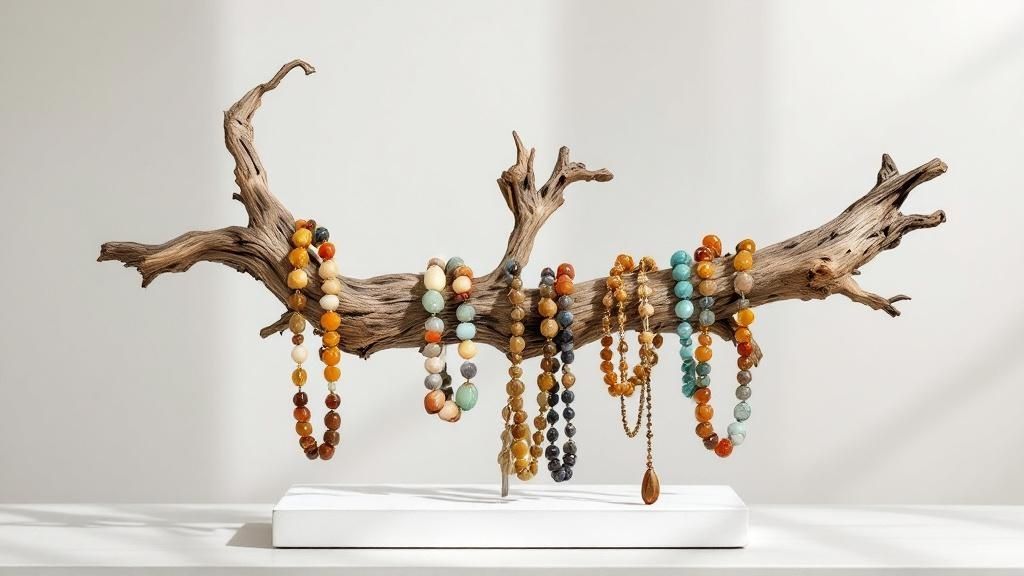Arthur Lynch | Wed Oct 08 2025
Creative Jewelry Vendor Display Ideas to Attract Customers
In the crowded marketplace of craft fairs, pop-ups, and boutiques, your jewelry's sparkle is only half the story. The other half is told by your presentation. An exceptional display does more than just hold your inventory; it stops passersby, tells your brand's story, and transforms casual browsers into loyal customers. This guide moves beyond generic advice, offering eight actionable and trend-aware jewelry vendor display ideas designed to captivate your audience and elevate your sales.
We'll explore strategies that align with global and regional fashion trends, ensuring your setup is not only beautiful but also commercially effective. From maximizing vertical space to creating immersive, theme-based experiences, these insights will help you build a display that works as hard as you do. You will learn how to leverage everything from classic bust forms to modern pegboard systems, turning your booth into a true sales magnet. Each idea is crafted to be practical, visually compelling, and ready for immediate implementation. Let's dive into the concepts that will make your collection unforgettable.
1. Vertical Tiered Display Stands
When table space is at a premium, thinking vertically is a game-changer. Vertical tiered display stands are one of the most effective jewelry vendor display ideas for creating an impactful, professional-looking booth. These multi-level structures draw the customer's eye upward, creating a dynamic visual journey that prevents your display from looking flat and uninspired. They allow you to showcase a diverse range of products, from delicate necklaces to statement earrings, without cluttering your valuable counter space.

This method works because it mimics the natural way people scan a retail environment, creating multiple focal points at different heights. It’s a strategy seen everywhere from high-end retailers like Pandora, who use rotating acrylic stands for their charms, to independent artisans at craft markets utilizing rustic bamboo or sleek metal tiers.
How to Implement Tiered Displays Effectively
To make the most of this approach, strategic placement and organization are key. The goal is to guide your customer’s attention and make browsing easy and enjoyable.
- Eye-Level is Buy-Level: Position your best-selling or most visually striking pieces on the middle tiers, which are typically at direct eye level. This is the prime real estate to feature pieces that align with current trends, like bold '80s-inspired chain necklaces or layered looks popular in European markets.
- Create Cohesive Groupings: Dedicate specific tiers to certain collections, colors, or jewelry types. For example, a tier for gold-plated hoops, another for gemstone necklaces, and a third for minimalist silver rings. This organized approach helps customers quickly find what they are looking for and tells a clear brand story.
- Material and Color Contrast: Choose a stand material that makes your jewelry pop. For instance, dark wood or black velvet tiers make silver and brightly colored gems stand out, while a light-colored or acrylic stand is perfect for showcasing darker or more intricate metalwork.
Key Insight: Vertical displays aren't just for saving space; they create a hierarchy of importance. Use the top tier for aspirational, high-ticket items and the bottom tiers for impulse buys or smaller pieces.
2. Bust and Neck Display Forms
Nothing helps a customer visualize how a necklace will truly look better than seeing it on a human-like form. Bust and neck display forms are essential jewelry vendor display ideas because they provide immediate context and a sense of scale. These three-dimensional mannequins, ranging from simple neck stands to full upper torso displays, transform your necklaces and pendants from simple objects into wearable art, creating an elegant, boutique-style atmosphere.

This display method is a classic for a reason. High-end retailers like Tiffany & Co. use them to convey luxury, while modern brands like Kendra Scott use busts in signature brand colors to reinforce their identity. The power of the bust form lies in its ability to tell an instant story about the piece, showing exactly how it will drape and fall when worn. This removes guesswork for the customer and elevates the perceived value of your jewelry.
How to Implement Bust Displays Effectively
To make your bust forms work for you, think of them as silent salespeople. They should be styled and positioned to showcase your jewelry in the best possible light, encouraging interaction and admiration.
- Choose Complementary Materials: The material of your bust form should enhance, not compete with, your jewelry. A clean white linen or neutral beige form is perfect for showcasing vibrant, colorful gemstones, a trend popular in both global and Middle Eastern markets. Conversely, a rich black velvet bust makes sterling silver and delicate diamonds pop with dramatic contrast.
- Create a Dynamic Landscape: Avoid a static lineup of busts all facing forward. Instead, group them in clusters of three or five at varying heights by using acrylic risers or decorative boxes. Turn some at slight angles to create a more natural, engaging scene that invites customers to view your collection from different perspectives.
- Showcase Layering Trends: Use multiple necklaces on a single bust to demonstrate how to achieve a popular layered look. Combine a choker, a pendant, and a longer chain to inspire customers and increase the potential for multiple-item sales. This actionable styling tip directly reflects trends seen in fashion hubs from Los Angeles to Seoul.
Key Insight: Invest in high-quality, photogenic bust forms. They serve a dual purpose by not only elevating your in-person display but also acting as the perfect models for professional-looking product photos for your e-commerce site and social media channels.
3. Ring Holder Trees and Branches
Moving beyond traditional ring trays, ring holder trees and branches offer a whimsical and organic way to showcase your collection. These are among the most artistic jewelry vendor display ideas, transforming a simple product presentation into a sculptural focal point. These decorative structures, resembling either natural tree branches or abstract forms, allow rings to be slipped onto individual "twigs," creating an enchanting, easy-to-browse display that captures attention instantly.

This method is particularly effective because it introduces an element of nature and artistry, telling a story about the jewelry's inspiration. It's a popular choice for brands with a bohemian or nature-inspired aesthetic, like those seen on Etsy using real driftwood, but it’s also been adopted in high-end retail. Modern brands like Mejuri use minimalist gold-wire trees to maintain a sleek, contemporary feel, proving the concept's versatility across different brand identities.
How to Implement Ring Trees Effectively
To create a visually stunning and shoppable display, the key is to balance aesthetics with functionality. Your goal is to make the rings look like treasures discovered in a forest.
- Match the Tree to Your Brand Vibe: The material of your tree holder is a powerful brand signal. Use rustic, natural manzanita branches for a bohemian or eco-conscious collection. Opt for sleek metallic or white-painted branches for a modern, minimalist line. The global trend towards sustainable and natural materials makes real wood branches particularly relevant.
- Don't Overcrowd the Branches: The beauty of this display is its airy, uncluttered feel. Leave ample space between each ring to allow customers to see the full design and easily remove it for a closer look. It’s better to use multiple smaller trees than one large, overloaded one.
- Organize by Trend or Material: Group rings to reflect current styles. For example, dedicate one branch to minimalist stacking rings, another to bold cocktail rings featuring oversized gems—a trend seen on runways globally—and a third to a specific metal like rose gold. This helps trend-conscious shoppers find what they’re looking for instantly.
Key Insight: Ring trees turn a simple product into a decorative object. This elevates the perceived value of your rings and encourages customers to envision the pieces not just as accessories, but as miniature works of art.
4. Glass Display Cases with Lighting
For vendors showcasing high-value, delicate, or one-of-a-kind pieces, nothing communicates professionalism and security better than a glass display case with integrated lighting. These enclosed displays create a high-end boutique atmosphere, protecting your inventory from dust, damage, and theft while dramatically enhancing its visual appeal. This approach is a cornerstone of jewelry vendor display ideas for those looking to elevate their brand perception and safeguard their most precious items.

The enclosed nature and focused illumination of these cases draw customers in for a closer, more considered look. This method is used universally, from luxury brands like Cartier and Harry Winston, who build their entire store experience around them, to independent artisans at high-end craft fairs using portable, lockable countertop units. The principle is the same: create a secure, museum-like setting that highlights the craftsmanship and beauty of each piece.
How to Implement Lighted Cases Effectively
Properly utilizing a lighted display case involves more than just placing jewelry inside; it's about creating a miniature, curated exhibition that tells a story and entices buyers.
- Choose the Right Light: Use LED lighting to avoid heat that can damage sensitive gemstones over time. Opt for cool, white light to make silver, platinum, and diamonds sparkle—essential for the bridal market. Use a warmer-toned light to enhance the rich glow of yellow gold, a metal currently seeing a major resurgence in global fashion. Similar principles apply to capturing your jewelry's best features in photos, a skill you can refine by exploring jewelry photography tips from jewelrybuydirect.com.
- Strategic Interior Design: Don't lay pieces flat. Use risers, necklace busts, and ring holders of varying heights to create a dynamic, multi-level arrangement inside the case. A dark velvet or linen lining can make metals and gems pop, while a neutral tone supports a minimalist aesthetic.
- Maintain Flawless Presentation: The glass must be spotlessly clean at all times. Fingerprints and smudges detract from the professional look and obscure the view of your jewelry. Keep a microfiber cloth handy and wipe the case down frequently throughout the day.
Key Insight: A locked glass case creates a psychological barrier that increases perceived value. Shoppers understand that items under lock and key are special, justifying higher price points and encouraging more serious inquiries.
5. Pegboard and Grid Wall Systems
For the ultimate in customization and modular design, pegboard and grid wall systems are brilliant jewelry vendor display ideas. These versatile backdrops, featuring either evenly spaced holes or a metal grid, allow you to create a completely unique and reconfigurable display. By using a variety of hooks, shelves, and specialty hangers, you can build a dynamic vertical landscape that can be changed in minutes to highlight new collections or adapt to different event spaces.
This method has been popularized by modern boutiques and DIY-savvy makers for its industrial-chic aesthetic and incredible flexibility. Brands like Urban Outfitters use grid walls to create an edgy, urban feel for their accessories, while independent designers on Instagram showcase their pieces on minimalist, painted pegboards. The system allows for a clean, organized presentation that lets the jewelry itself be the hero.
How to Implement Pegboard and Grid Wall Systems Effectively
Success with this system lies in thoughtful arrangement and a strategic use of accessories. The goal is to create a display that is both functional for browsing and visually appealing.
- Embrace Brand Colors: Paint your pegboard to match your brand's color palette. A crisp white or soft pastel can create a clean, minimalist backdrop, while a bold, dark color will make metallic or gemstone jewelry stand out dramatically.
- Create Visual Zones: Don't just hang items randomly. Group jewelry by collection, color story, or type. Create a specific section for "trending now" pieces, like charm necklaces or beaded styles popular on social media platforms, to immediately catch the eye of fashion-forward shoppers.
- Balance and Negative Space: Resist the urge to fill every single hole or grid square. Leaving "white space" around your pieces is crucial for preventing a cluttered look. This gives each item room to breathe and helps customers focus on individual designs without feeling overwhelmed.
Key Insight: Elevate your pegboard or grid wall by incorporating non-jewelry elements. Add small, decorative baskets for business cards, clip-on signage with your brand story, or even a small hanging plant to introduce texture and personality.
6. Jewelry Display Trays with Compartments
For vendors who need to present a high volume of smaller items like rings, earrings, or charms, compartmentalized display trays are essential jewelry vendor display ideas. These trays bring a clean, professional, and boutique-like feel to any setup. By providing a dedicated slot or section for each piece, they prevent tangling and clutter, allowing customers to easily view and compare individual items without feeling overwhelmed. They instantly elevate your display from a simple table of goods to a curated collection.
This method is a standard for a reason; it works. High-end retailers like Kay Jewelers use plush velvet trays in their cases to showcase engagement rings, while artisans at craft fairs rely on linen-lined trays to organize dozens of earring pairs. The structured format communicates value and care, suggesting that each piece is important enough to have its own space.
How to Implement Display Trays Effectively
Using trays is about more than just organization; it’s about creating an inviting and shoppable experience. Strategic use can guide customers through your offerings and boost sales.
- Create Visual Contrast: Select tray materials and colors that make your jewelry stand out. A dark charcoal or velvet tray is perfect for highlighting the brilliance of silver or brightly colored gemstones, while a light-colored linen or burlap tray provides a beautiful backdrop for darker metals or earth-toned pieces.
- Organize for Action: Dedicate specific trays to certain collections, styles, or price points. Create a "mix-and-match" earring stud tray to encourage multiple purchases, tapping into the "ear party" trend. Have another tray for birthstone jewelry, organized by month, for easy gifting. This makes the shopping process intuitive and targeted.
- Angle for Better Viewing: Don't lay trays completely flat. Use small easels, risers, or even simple wooden blocks to prop them up at a slight angle. This small adjustment makes the jewelry more visible to standing customers and creates a more dynamic, multi-level display. Don’t overfill the compartments; giving each piece some breathing room enhances its perceived value.
Key Insight: Use multiple smaller trays instead of one large one. This modular approach allows for more flexible layouts, makes it easier to create visual height differences by stacking, and lets you bring out specific collections for interested customers without disrupting the entire display.
7. Creative Theme-Based Displays
Moving beyond standard displays, a theme-based setup transforms your booth into an immersive brand experience. This is one of the most powerful jewelry vendor display ideas because it tells a story and creates an emotional connection with shoppers. Instead of just showing products, you’re curating an environment that reflects your brand’s unique identity, using props like vintage books, natural elements, or architectural pieces to hold and highlight your jewelry.
This narrative approach is famously used by retailers like Anthropologie, who excel at visual merchandising, and by countless successful Etsy artisans. A coastal brand might use driftwood to display necklaces, while a vintage-inspired line could use antique teacups to hold delicate rings. The goal is to make your display memorable and highly shareable on social media.
How to Implement Theme-Based Displays Effectively
A successful theme feels authentic and enhances the jewelry, rather than overshadowing it. The key is to create a cohesive and functional presentation that captivates your audience.
- Align Theme with Brand Identity: Your theme must be a true reflection of your brand. If your jewelry is minimalist and modern, use clean lines, geometric props, and a monochrome palette. For a bohemian brand, incorporate natural elements like moss, wood, and raw crystals to align with global trends favoring organic and earthy aesthetics.
- Use Props as Functional Displays: Don’t just place props around your jewelry; integrate them. Drape a delicate gold necklace over a stack of classic novels for a literary theme, or nestle gemstone rings within a bed of lush, green moss for an enchanted forest vibe. Use beautiful ceramic dishes to hold earrings, reflecting the "dopamine dressing" trend with pops of color.
- Functionality is Paramount: Ensure your creative setup is practical. Jewelry must be easy for customers to see and access, and simple for you to restock. Test the stability of all props; a beautiful display that constantly topples over is a liability. For more inspiration, you can learn more about creative retail display ideas.
Key Insight: A theme-based display turns your booth into a destination. It’s not just a place to buy jewelry; it's an Instagrammable moment that customers will remember and share, providing organic marketing long after the event is over.
8. Rotating and Lighted Display Cases
To capture attention in a crowded market, incorporating movement and light is a powerful strategy. Rotating and lighted display cases are sophisticated jewelry vendor display ideas that add a dynamic, high-end feel to your booth. These motorized platforms, often equipped with integrated LED lighting, showcase your premier pieces from every conceivable angle, creating a mesmerizing effect that draws customers in. The gentle motion and focused light work together to make gemstones sparkle and metalwork gleam, ensuring your hero products cannot be ignored.
This technique was pioneered by luxury watch brands like Rolex and Omega to convey precision and elegance. Today, it's used effectively by everyone from high-end retailers like Swarovski, who use dramatic lighting on rotating crystal displays, to artisans at trade shows highlighting their signature collections. The constant, slow rotation allows potential buyers to appreciate the full 360-degree craftsmanship of a piece without needing to handle it.
How to Implement Rotating Displays Effectively
Using motion requires a delicate balance; the goal is to attract, not distract. Strategic implementation is crucial for creating a luxurious and effective focal point.
- Highlight Your Stars: Reserve these displays for your most valuable, intricate, or best-selling items. Overuse can create sensory overload, but dedicating one or two rotating platforms to your top pieces gives them the special status they deserve.
- Control the Speed and Light: Set the rotation speed to be slow and graceful, ideally around 60 to 90 seconds for a full revolution. This allows for optimal viewing without causing dizziness. Use focused, cool-toned LED lighting to maximize sparkle, especially for diamonds, moissanite, and faceted gemstones, a trend popular in both Western and Middle Eastern markets.
- Actionable Placement: Position your rotating display at eye level to capture maximum attention. Use it in a window to attract street traffic or as a central beacon within your booth to draw shoppers from the aisle. Always ensure pieces are securely fastened to prevent them from shifting or falling.
Key Insight: A rotating display with a mirrored base can create a powerful optical illusion. It not only enhances the light and sparkle but also makes your featured collection appear more abundant and impressive, adding perceived value.
Jewelry Vendor Display Ideas Comparison
| Display Type | Implementation Complexity | Resource Requirements | Expected Outcomes | Ideal Use Cases | Key Advantages |
|---|---|---|---|---|---|
| Vertical Tiered Display Stands | Low to Moderate | Materials (acrylic, wood, metal), stable base | Maximizes vertical space, clear visibility | Craft fairs, small retail counters, pop-up shops | Compact footprint, eye-catching, displays many pieces |
| Bust and Neck Display Forms | Moderate | Specialized forms (velvet, linen, acrylic), space needed | Realistic presentation, elevates jewelry value | Permanent retail, high-end lines, professional craft shows | Shows jewelry worn look, professional appearance |
| Ring Holder Trees and Branches | Low | Materials (metal, wood, resin), stable base | Artistic, organized ring display | Ring-focused vendors, bohemian/nature-inspired brands | Affordable, visually memorable, easy browsing |
| Glass Display Cases with Lighting | High | Tempered glass, LED lighting, locks, electricity | High security, professional presentation | Permanent retail, high-value collections, professional shows | Security, enhanced sparkle, protects from damage |
| Pegboard and Grid Wall Systems | Moderate | Panels (metal, wood, plastic), hooks and accessories | Highly flexible, easy reconfiguration | Budget-conscious vendors, modern/urban brands, craft fairs | Versatile, customizable, cost-effective |
| Jewelry Display Trays with Compartments | Low | Velvet or fabric trays, compartments | Organized, professional presentation | Extensive inventory sellers, trade shows, permanent counters | Organized, portable, protects jewelry |
| Creative Theme-Based Displays | Moderate to High | Varied props, DIY or repurposed materials | Unique, memorable brand identity | Artisan jewelers, social media-focused brands, boutique retailers | Distinctive, shareable, flexible themes |
| Rotating and Lighted Display Cases | Moderate | Motorized bases, LED lighting, power source | Dynamic presentation, attracts customer attention | Premium brands, featured collections, trade shows, window displays | 360° view, movement draws attention, lighting effect |
Putting It All Together: Crafting Your Signature Display
Your display is more than just a setup of stands and props; it is the silent salesperson that communicates your brand's story, quality, and unique aesthetic. Throughout this guide, we've explored a range of dynamic jewelry vendor display ideas, from leveraging vertical space with tiered stands to creating immersive experiences with thematic setups. The true artistry, however, lies in how you combine these elements to create a cohesive and captivating presentation that stops customers in their tracks.
The most effective displays are not static. They are a living, breathing part of your business that evolves with your inventory, the changing seasons, and emerging global fashion trends. Think of your booth or retail space as a stage, where your jewelry pieces are the stars. A combination of classic bust forms for statement necklaces, elegant ring trees for delicate pieces, and secure glass cases for high-value items creates a balanced and professional look. This layered approach allows you to guide the customer's eye, tell a story, and highlight your most compelling products effectively.
Key Takeaways for a Powerful Display
As you refine your strategy, remember these core principles:
- Create a Hierarchy: Don't let your display become a flat sea of sparkle. Use varying heights with tiered stands and risers to create visual interest and draw attention to specific collections or hero pieces. This simple technique can dramatically improve how customers navigate your offerings.
- Tell a Story with Themes: A theme transforms your display from a simple product showcase into a memorable experience. Whether it's a minimalist Scandinavian aesthetic, a bohemian desert vibe, or a glamorous vintage Hollywood setup, a strong theme makes your brand unforgettable and helps customers envision how the jewelry fits their personal style.
- Lighting is Non-Negotiable: Strategic lighting is the single most impactful element for making jewelry shine. Integrating LED strips into cases, using focused spotlights, or employing rotating lighted displays ensures that every facet and detail of your craftsmanship is brilliantly illuminated. Good lighting conveys quality and luxury.
- Balance Security and Accessibility: While open displays using trays and pegboards invite interaction, high-value items require the security of locked glass cases. A successful setup finds the right balance, making most of your inventory touchable while protecting your most precious pieces, building trust with your customers.
Your Next Steps to Success
Mastering these jewelry vendor display ideas is a crucial step toward converting passersby into loyal customers. The goal is to create an environment that feels both aspirational and approachable, encouraging shoppers to engage, try on pieces, and ultimately, make a purchase. Your display is a direct reflection of the care and passion you pour into your jewelry; let it speak for you. By thoughtfully selecting and arranging your displays, you not only enhance the perceived value of your products but also build a powerful brand identity that resonates long after the sale is made.
Ready to stock your stunning new display with high-quality, trend-forward pieces? Explore the endless possibilities at JewelryBuyDirect, where you can source over 120,000 styles directly from the factory with no minimum order. Visit JewelryBuyDirect to find the perfect inventory to make your display truly shine.

 to show code
to show code







































































































































































